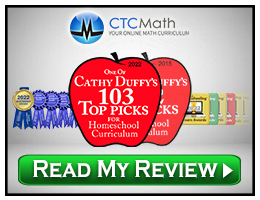JUMP Math for kindergarten through eighth grade uses an interactive “structured inquiry” approach that encourages children to think about math concepts and come to a deep understanding of why and how math processes work. Courses must be taught by a parent or teacher using the interactive approach laid out in scripted lesson plans, and their layout is quite different from most math programs.
Each course requires the Teacher Resource (print and digital options) and the two-part Assessment & Practice books (available only as printed books). (Other components are available as described below.) Homeschoolers also need to sign up for an annual membership that ranges from free to $149.99 (minus a homeschool discount). While there are four membership options, only three apply to most homeschoolers—Basic, Educator Pro, and Educator Premium. All memberships provide access to all grade levels, so only one membership is required for a homeschooling family, even for those teaching more than one grade level. The membership levels are:
Basic (Free): includes access to answer keys for student workbooks for grades 3 through 8. (Answer keys for levels K through 2 are included in the pertinent Teacher Resource.) With this membership, you can also access sample K–8 lessons, JUMP Math Lab, and Mighton Math Minutes. Note that no Teacher Resources, quizzes, or tests are included, but this level of membership will work for those who don’t need them.
Educator Pro ($119.99): includes access to the Teacher Resources for all levels, modifiable quizzes and tests with answer keys, assessment checklists, answer keys for the student Assessment & Practice workbooks, generic blackline masters, a list of required resources for lesson presentations, homework pages (one per lesson), JUMP Math Lab, and more. You can teach one or more grade levels, with the only additional cost being that for the Assessment & Practice student books for each level.
Educator Premium ($149.99): everything in the Pro membership plus access to Accumula lessons, which I describe below. (This is a combination of the Pro and Plus memberships.)
Educator Plus ($89.99): access to the JUMP Math Accumula supplemental lessons for grades 1 through 8, along with the Accumula teacher guide, quizzes, and tests. (A Lumio subscription is also required.) This option is only for those who need the extra lessons.
Homeschoolers can sign up for a basic membership, but they still have to purchase a print or digital version of the Teacher Resource and printed student workbooks. A printed version of the Teacher Resource for each level costs more than $200, while a digital version is $176 (minus a homeschool discount). So a Pro or Premium membership probably costs less than the Teacher Resource alone, and both those memberships include quizzes and tests.
The optional Accumula student workbook for each course is available for students who need extra practice or have gaps in their background. Accumula books work in conjunction with interactive online lessons on Lumio, accessed through a separate subscription. The quizzes and answer keys for Accumula are available only through a membership, and beyond the first few grades, you probably need both.
Teacher Resource
If you purchase a Teacher Resource outside a membership (whether print or digital), you automatically get a one-year membership at the Pro level, so you will have access to quizzes and answer keys.
The Teacher Resource in print or as digital files (rather than through the membership resource center) divides each course into two parts, and you can quickly view the lessons for a semester. In contrast, the online Teacher Resource (through a membership) lets you download or view one lesson at a time, and blackline masters must be downloaded individually. (It would be helpful if an entire lesson, both teaching pages and blackline masters, could be downloaded with one click.)
The Teacher Resource has scripted lesson plans and printable masters for manipulatives (e.g., pattern blocks and number cards), formatted pages (e.g., for graph paper and a multiplication chart), and lesson worksheets. There are more such masters for the earlier grades than for succeeding grade levels. (Note that “BLM” in the lesson plans stands for blackline masters for manipulatives and worksheets.)
Lesson plans were written for class situations, often directing the teacher to ask students to compare results, share their predictions, or have other interactions likely to elicit differing responses. If necessary to make a point, parents might need to raise a possible response to help their students consider more than one possibility. After the presentation of a new concept, lessons include interactive exercises presented by the teacher so that students can check their comprehension. Answers follow immediately after each exercise. Extension exercises provide more interactive problem-solving to use as needed.
Some students will grasp concepts quickly or already understand them, and it is important that parents working with just one or two students adjust lesson presentations when this is the case. If a parent thinks their child already understands a concept, he or she might ask the child to explain or apply the concept in a way that demonstrates understanding. If a child can do this with confidence, then the parent can skip that lesson presentation. I realize that some parents feel obligated to use all the scripted lesson plans, but this program does not require that parents teach every lesson when it is not needed.
Course introductions in the Teacher Resource explain the program’s approach, which utilizes several teaching strategies. Those strategies include using manipulatives, whiteboard drawings, games, and conversations. The discovery aspect of the lessons often happens through conversations, coupled with illustrations and activities. The JUMP Math website explains further:
Unlike teaching methods that rely on textbooks, rote learning or memorization, our approach helps children overcome “math anxiety” by building their confidence and resilience through tackling incrementally more challenging concepts at each stage of learning. This leads to success at understanding math – not just memorizing concepts.
The program’s close correlation with the Common Core State Standards for Mathematics is laid out in the Teacher Resources.
A few other features are particularly worth noting. All pages are printed in black and white to avoid the distraction of color. Games are often used as part of the teaching strategies. While many require a group of children, some can easily be adapted for a single student working with a parent. Lessons at the younger levels often use additional resources such as counters, pipe cleaners or clay for forming numbers, or a storybook, such as Goldilocks and the Three Bears (used in a first-grade lesson on comparing capacities). Some lesson preparation is necessary to make sure all required resources are on hand and that the teacher understands the lesson objectives.
Assessment & Practice Workbooks
The Assessment & Practice (AP) workbooks provide opportunities for students to work on their own. These are not standalone workbooks but are dependent on lesson presentations from the Teacher Resources. Continuous assessment is part of this program, and it occurs through the child’s work in the AP books. As children complete the exercises, parents spot when students haven’t fully understood concepts and reteach as needed. Answer keys for the AP books and actual quizzes are both available through the memberships.
Students can write most answers directly on the pages of their AP books, but a notebook icon alerts them when they need to write answers in a separate notebook. Grid pages created by using the graph paper blackline master are recommended for that purpose.
Other Resources
Among other resources in the resource center (available through Pro and Premium memberships) are Mighton Minutes (many by John Mighton), Assessment Checklists for kindergarten (rather than quizzes), Confidence Building Units that might help students overcome math anxiety, homework pages, and pacing guides. Mighton Minutes are short videos for educators and parents that address topics such as “How to Quickly Catch Students Up in Math,” “Math Anxiety,” and “Math Games That Make Learning Fun!”
JUMP Math Lab (included in Basic, Pro, and Premium memberships) is a new online platform that provides additional support for students in grades 3 through 8. It should be especially helpful for those who have not mastered concepts already taught at earlier levels. It’s usable, but watch for more content and improvements.
Parents can assign lessons that align with the curriculum or select other modules with lessons that cover whatever topic they want.
Since it was designed for class situations, it takes a little work up front to set up an account for a teacher and student. (A video walks us through the process.)
The program tracks and produces reports on student work.
Summary
The structured inquiry approach used by JUMP Math is very effective, but it does require direct instruction, making it a good choice for parents with the time and inclination to present the lessons.








